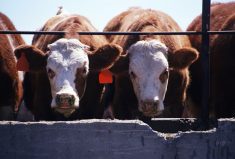Chicago | Reuters — The number of cattle placed into U.S. feedlots last month declined four per cent from a year ago to their lowest level for October since the government began tabulating the data in 1996, a U.S. Department of Agriculture report showed on Friday.
October’s placement results nearly matched forecasts by analysts, who cited burdensome supplies of heavier animals that weighed on cattle prices and eroded profit for feedyards.
Abundant grazing pasture and affordable feed also allowed ranchers to grow cattle outside of feeding pens longer as leverage against lower prices for their animals.
Read Also

Bring focused approach to target systems, not producers says animal activist
Darren Vanstone explains the process of reframing animal agriculture through advocacy and activism at the Human Canada One Health One Welfare Conference.
USDA’s data on Friday indicated the number of cattle placed on feed by weight class continued to decline year-over-year for all categories except that above 800 lbs.
Cattle that were put in feedlots last month should begin showing up at packing plants in early spring 2016, which could exert modest price pressure at that time, the analysts said.
Friday’s USDA report showed October placements at 2.281 million head, down four per cent from 2.368 million last year, and close to analysts’ average forecast of 2.273 million.
USDA put the feedlot cattle supply as of Nov. 1 at 10.794 million head, up two per cent from 10.571 million a year ago. Analysts, on average, had forecast a 2.2 per cent gain.
The government said the number of cattle sold to packers, or marketings, declined three per cent in October from a year ago, at 1.63 million head.
Analysts projected a four per cent drop from 1.685 million last year.
Other than the marketing outcome that was slightly larger than expected, the results were generally neutral across the board, said Allendale Inc. chief strategist, Rich Nelson.
“This makes four months in a row of placements lower than last year, insuring manageable supplies through the first-quarter slaughter period,” he said.
Jim Robb, director of the Colorado-based Livestock Marketing Information Center, said the continued trend of yearly increases in the 800-lb. category suggests an ongoing trend as the industry builds the overall cattle inventory.
“There is plenty of forage and increasing wheat pasture in most of the country to hold animals and to continue this pattern of placing heavier-weight cattle,” he said.
USDA’s generally neutral report should have little influence next week on Chicago Mercantile Exchange live cattle investors, who will likely focus on Friday’s prices for slaughter cattle and beef at wholesale, analysts said.
— Theopolis Waters reports on livestock futures for Reuters from Chicago.















